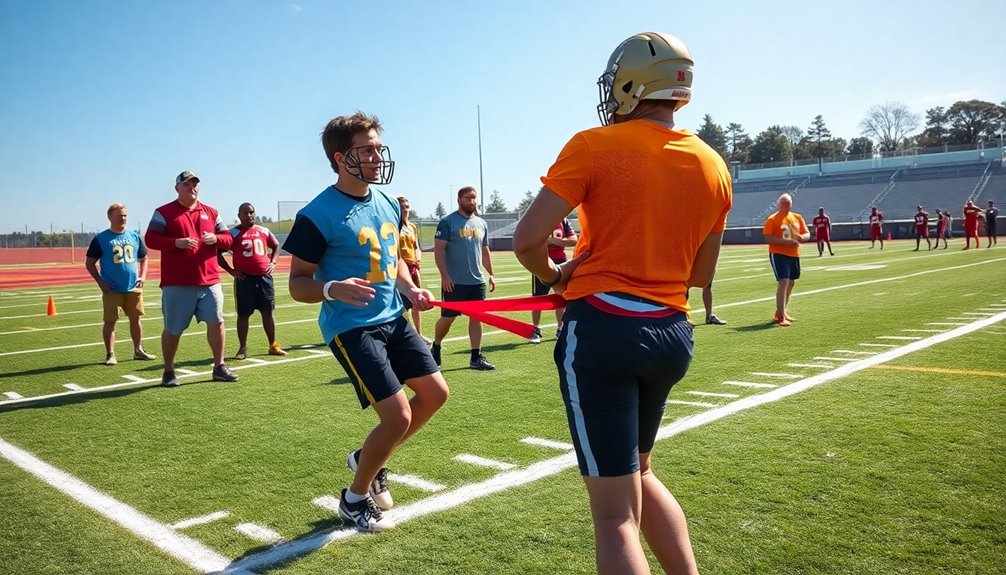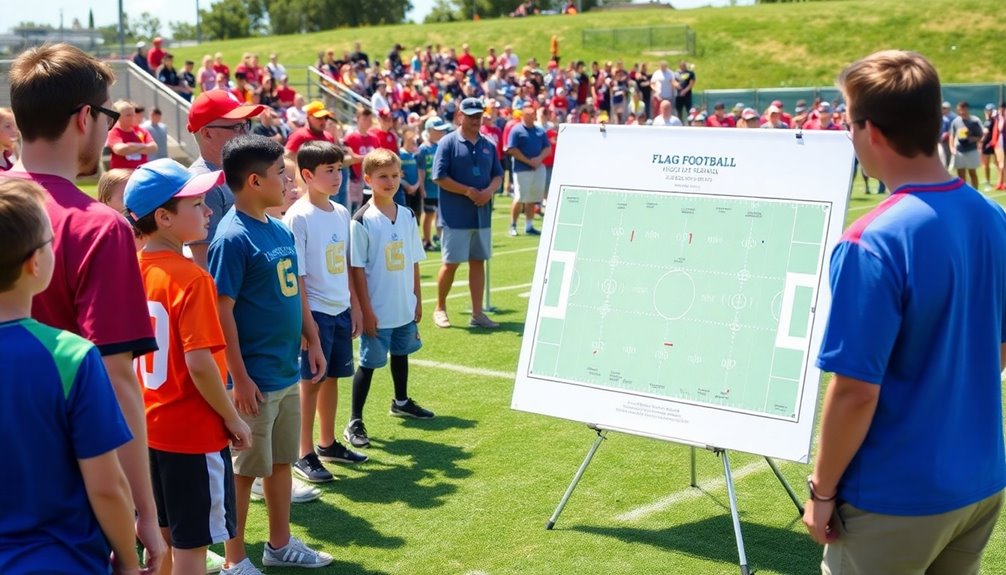
Understanding NFL Flag Football Rules Made Easy
January 5, 2025Understanding NFL Flag Football rules makes your experience on the field enjoyable and rewarding. Each team has five players, and the game takes place on a 70 by 30-yard field. You can't tackle or block, so flag pulling is key. You've got four downs to cross midfield, and scoring a touchdown gives you 6 points. Pay attention to the pass clock, which is 7 seconds, and remember to communicate with your teammates. Knowing common penalties can save you from losing yardage. Stick around, and you'll uncover valuable strategies to enhance your gameplay and teamwork!
Overview of Flag Football
Understanding NFL Flag Football Rules Made Easy
Overview of Flag Football
NFL Flag Football offers an exciting, non-contact alternative to traditional tackle football. In this youth sport, teams consist of five players, focusing on skill development and teamwork without the risks associated with tackle football. Mastering basic soccer skills can also enhance teamwork in flag football.
Each game is played on a field measuring 30 yards wide and 70 yards long, featuring two 10-yard end zones.
As an offensive team, you have four downs to cross the midfield line. If you succeed, you get another four downs to score, with a touchdown worth 6 points. The gameplay is designed to be strategic, as all passes must be forward and received beyond the line of scrimmage.
Plus, the quarterback has a seven-second pass clock to release the ball, keeping the game fast-paced and exciting.
Players wear flags, which defenders pull to stop the play instead of tackling. This non-contact version of football promotes inclusivity, with FLAG football leagues available for players aged 5 to 17, encouraging both genders to participate. Additionally, understanding key regulations can enhance your enjoyment of the game.
Field Dimensions and Equipment
In NFL Flag Football, the field dimensions are vital for gameplay, measuring 30 yards wide and 70 yards long, with two 10-yard end zones at each end. This setup provides a clear structure for teams to navigate during the game. The evolution of various ball games, including modern soccer, influenced the design and organization of competitive sports fields. The designated area for goal kicks and free kicks in soccer parallels the strategic placement of zones in flag football, highlighting the importance of field layout.
You'll find midfield lines that indicate the line-to-gain for first downs, and it's significant to recognize the 5-yard no run zones. When in these zones, teams must pass the ball rather than run, adding an exciting strategic element to the game.
As for equipment, each player wears flag belts with flags attached, which are fundamental for the game's mechanics. Make sure you're wearing jerseys and cleats, but remember, metal cleats are prohibited for safety reasons.
To protect your teeth, wearing mouthguards is highly recommended. During practice and games, soft, lightweight footballs are used to guarantee safety and ease of handling. Additionally, cones or markers define field boundaries and assist in organizing practice drills.
Understanding these field dimensions and equipment requirements will help you feel more prepared and confident on the field. Moreover, knowing the importance of sportsmanship and respect can enhance the overall experience for everyone involved in the game.
Basic Gameplay Rules

In NFL Flag football, understanding the no contact regulations is essential to maintaining fair play and safety.
You'll need to master flag pulling mechanics to effectively stop the opposing team's ball carrier, while also focusing on the passing and scoring rules to maximize your team's chances of success. Additionally, practicing proper form during flag pulls can enhance your effectiveness and reduce the risk of penalties. It's also important to recognize the significance of opponents' positioning in both offensive and defensive strategies to ensure you capitalize on scoring opportunities. Knowing how to utilize quick footwork can further improve your chances of successfully pulling flags during the game.
Knowing these basics will set you up for a great game experience.
No Contact Regulations
Understanding no contact regulations is vital for anyone participating in NFL flag football. No contact means tackling, plunging, blocking, and screening are strictly prohibited. This rule is fundamental for player safety and creates a non-violent playing environment where everyone can enjoy the game. Instead of tackling, players wear flag belts, and a "tackle" occurs when a defender pulls a flag from the ball carrier's belt.
The focus on no contact allows for significant skill development and strategic gameplay. With the removal of traditional linemen, the game emphasizes agility and speed, making it accessible to a broader range of participants.
You'll find that the absence of physical contact promotes fair play, encouraging players to rely on their skills and quick thinking rather than brute strength.
As you engage with NFL flag football, remember that adhering to these regulations not only guarantees safety but also enhances the overall experience for you and your teammates.
Embrace the game's fast-paced nature and develop your strategy while enjoying the thrill of competition without the risk of injury that often accompanies contact sports.
Flag Pulling Mechanics
Mastering flag pulling mechanics is essential for effective defensive play in NFL flag football. As a defensive player, your primary goal is to stop the ball carrier by pulling one or both of their flags. This action is the only legal method to "tackle" in the game, reinforcing the need for precise mechanics and technique.
To execute flag pulling successfully, you must focus on your footwork and positioning. Track the ball carrier closely, anticipating their movements while maintaining a safe distance to avoid any physical contact.
Remember, tackling, blocking, and diving are prohibited to guarantee player safety, so you'll need to rely on agility and strategy. Position yourself strategically to minimize the ball carrier's options, making it easier to reach and pull their flags.
When you're in the right spot, use quick, decisive movements to grab the flags, guaranteeing that you're not making any contact with the player. Effective flag pulling requires practice, as well as an understanding of the rules, to enhance your skills and contribute to your team's defensive efforts.
With dedication, you'll become a formidable opponent on the field.
Passing and Scoring Rules
While maneuvering the fast-paced world of NFL flag football, grasping the passing and scoring rules is essential for your team's success.
Each offensive team is allowed one forward pass per play, which can occur behind the line of scrimmage. This rule opens up strategic passing opportunities. The quarterback has a 7-second pass clock to release the ball, pushing for quick decision-making and dynamic plays.
Your team has four downs to cross the midfield line; once you achieve this, you gain another set of four downs to score. Touchdowns are worth 6 points, and after scoring, you can choose to attempt a 1-point conversion from the 5-yard line or a 2-point conversion from the 10-yard line.
All players, including the quarterback, can act as eligible receivers, adding creativity to your passing game. This versatility allows for unexpected plays and better team coordination.
Mastering these passing and scoring rules won't only enhance your gameplay but also elevate your overall team strategy, making each offensive drive more effective.
Scoring System Explained
In NFL Flag football, scoring revolves around touchdowns, which are worth 6 points.
After a touchdown, you can choose to go for an extra point from the 5-yard line or a 2-point conversion from the 10-yard line. This scoring approach creates a similar emphasis on strategy and timing as the concept of stoppage time in soccer, where teams must make critical decisions under pressure. Additionally, if your team is stopped in its own end zone, the opposing team earns 2 points for a safety. The scoring system creates a dynamic competitive environment that can shift quickly, similar to the relegation dynamics in soccer where both promotion and demotion can drastically change a team's financial and competitive landscape. The impact of halftime breaks in soccer also underscores how crucial strategic pauses can be in determining overall match success.
Touchdown Points Breakdown
Understanding the scoring system in NFL flag football is vital for maximizing your team's performance on the field. A touchdown is your primary way to score, worth 6 points when a player crosses into the opponent's end zone with the ball. This achievement is essential, as it fuels your team's momentum and boosts morale.
After scoring a touchdown, you have the option to attempt an extra point conversion. You can choose a 1-point conversion from the 5-yard line or push for a 2-point conversion from the 10-yard line. This decision is part of the strategic play that can greatly impact the game. Teams must weigh the risks and rewards of these attempts, considering factors like time left on the clock and the score.
In NFL flag football, the scoring system emphasizes teamwork and strategy. By crossing midfield, you gain additional downs, which helps you maximize your scoring opportunities.
Extra Points Options
After scoring a touchdown, you face a critical decision regarding the extra point conversion. You can choose to attempt a 1-point conversion from the 5-yard line or a 2-point conversion from the 10-yard line. The choice you make can greatly impact your team's score and overall momentum.
If you opt for the 1-point conversion, your offensive team must successfully pass or run the ball into the end zone to score. This option is often seen as a safer bet, but it only adds a single point to your score.
On the other hand, the 2-point conversion involves a more challenging attempt, requiring your team to navigate from the 10-yard line into the end zone. If successful, this strategy nets you 2 points, but the risk is higher.
Safety Scoring Explained
A safety in NFL flag football can be a game-changer, providing your team with 2 valuable points. Safeties occur when the offensive team is downed in their own end zone during a play. This situation not only boosts your score but also shifts momentum in your favor.
In NFL Flag football, scoring primarily revolves around touchdowns, which are worth 6 points. After scoring a touchdown, teams can attempt a conversion for an additional point or two, depending on where they make the attempt. However, safeties present a unique scoring opportunity that can turn the tide of a game quickly.
It's essential to stay alert and recognize when the offensive team might be at risk of being downed in their end zone. If you can force the opposing team into that situation, you'll secure those valuable points and gain the upper hand.
Key Positions in Flag Football

Mastering the key positions in flag football is essential for building a successful team. The quarterback directs the offense, orchestrating plays and making strategic passes. While they can only run with the ball after handing it off, their decision-making is vital for maintaining possession.
Wide receivers excel at catching passes, using their speed and agility to create separation from defenders. They're the go-to players for passing plays.
Running backs play a versatile role, handling the ball during running plays, assisting in blocking, and sometimes acting as receivers on passing plays. They're key players in advancing the ball downfield.
On the defensive side, defensive backs work hard to intercept passes and cover wide receivers, preventing scoring opportunities by closely tracking offensive players.
Linebackers are equally important, as they defend against both run and pass plays. Positioned to react quickly, they provide essential support in stopping offensive plays.
Understanding these positions helps you appreciate the dynamics of the game and the skills required from each player. Whether offensive or defensive, each position contributes greatly to the team's overall performance and strategy. Additionally, the defensive prowess of each position can significantly impact a team's ability to control the game.
Offensive and Defensive Strategies
When you're on offense, effective playcalling techniques can make all the difference, especially with quick passes and strategic routes. Additionally, implementing passing accuracy techniques can significantly enhance your team's overall performance. A strong understanding of defensive stance drills helps players react quickly to opposing movements. On the defensive side, understanding formation strategies and how to counter offensive plays is essential for success. Incorporating principles like pressure can disrupt the opponent's attack and create opportunities for your team. Balancing game management tactics will help you maintain control and adapt to your opponent's strengths throughout the match. Consistent practice of defensive skills fosters a cohesive unit that is challenging to break down.
Offensive Playcalling Techniques
In NFL flag football, successful offensive playcalling hinges on quick decision-making and strategic formations. You'll need to focus on utilizing forward passes, as only one is allowed per play. The quarterback has a critical role here, operating under a 7-second pass clock that pushes for rapid play execution. This urgency helps prevent the defense from effectively setting up their defensive strategies.
When it comes to offensive formations, consider using spread concepts. These can create mismatches by allowing your receivers to separate from defenders, making it easier for the quarterback to find an open target.
In addition, be mindful of no run zones, where you must pass exclusively. This forces the defense to adjust and remain alert for potential scoring plays.
Defensive strategies often include flag pulling and zone coverage, so you'll want to anticipate how the defense might react. Effective communication and quick decision-making will be essential for your offense to exploit these defensive alignments.
Defensive Formation Strategies
Utilizing effective defensive formation strategies is essential for countering offensive plays in NFL flag football. You can choose between zone coverage and man-to-man marking, each offering unique benefits.
In zone coverage, defenders focus on specific areas of the field, allowing them to cover multiple offensive players effectively. This strategy is particularly useful when anticipating certain offensive formations.
On the other hand, man-to-man marking involves a defender closely following a specific offensive player, which helps prevent them from receiving the ball.
To make your defense even stronger, consider positioning a rusher 7 yards back from the line of scrimmage. This rusher targets the quarterback, creating pressure while the rest of your team covers potential receivers.
Remember, defensive players must pull the flag of the ball carrier to stop the play, so agility and quick reflexes are key.
Lastly, always stay aware of the offensive formation. If they line up with multiple receivers, adjust your coverage accordingly to prevent easy completions.
Game Management Tactics
Mastering game management tactics is crucial for both offensive and defensive success in NFL flag football. On offense, focus on implementing quick passes and lateral movements to exploit gaps in the defense. With a 7-second pass clock, you need to make swift decisions and guarantee your receivers run option routes that create separation, allowing them to maximize yardage after the catch.
Defensively, your players should prioritize positioning and practice effective flag-pulling techniques to limit the offense's yardage and scoring opportunities. Utilizing zone coverage can enhance your strategy, as it allows defensive players to anticipate the quarterback's moves and guard multiple receivers within a designated area.
Communication is essential for both sides; quick huddles help develop cohesive strategies that adapt to the opposing team's strengths and weaknesses. By staying connected and adjusting your tactics mid-game, you can maintain an edge over your opponents.
Implementing these strategies won't only improve your game management but also enhance your team's overall performance on the field. Remember, both offense and defense thrive on adaptability and teamwork!
Importance of Teamwork

Teamwork plays an essential role in NFL Flag Football, where effective communication and strategy execution are fundamental for success. As a player, you need to understand that every position has a designated role, whether you're the quarterback, receiver, or defensive back. This emphasizes collaboration, allowing each player to maximize their strengths and enhance overall performance.
In the fast-paced nature of flag football, you must work together seamlessly. Adapting quickly to changing situations on the field is critical, and this can only happen when players communicate effectively. Team drills and practice sessions build trust and understanding among teammates, which is essential for executing complex offensive and defensive strategies.
Moreover, flag football promotes inclusivity, encouraging players of all skill levels to contribute. This fosters a sense of community and teamwork among diverse participants, making each game more enjoyable.
Common Penalties and Infractions
What happens when players break the rules in NFL Flag Football? You'll encounter various penalties that can greatly impact the game.
Offensive penalties typically result in a loss of down and yardage. Common infractions include flag guarding—where you obstruct a defender from pulling your flag—and illegal motion, which can cost your team valuable ground.
On the flip side, defensive penalties often grant an automatic first down to the offensive team. You might see this for fouls like pass interference or unnecessary roughness.
It's essential to stay aware of field boundaries because stepping out of bounds automatically ends the play, disrupting your momentum.
Moreover, the 30-second play clock is critical in maintaining the pace of the game. If you fail to snap the ball within this timeframe, you'll incur a delay of game penalty, further hindering your offensive progress.
Understanding these common penalties and infractions helps you play smarter, making sure you avoid costly mistakes that can change the outcome of the game.
Stay alert, keep your fundamentals in check, and you'll navigate the rules of NFL flag football like a pro!
Tips for Coaches and Players

Effective coaching and player strategies can markedly enhance performance in NFL flag football.
First, make sure you understand that only forward passes are allowed and must be completed beyond the line of scrimmage. This knowledge is essential for developing effective offensive plays within the NFL FLAG program.
Players should focus on mastering flag pulling techniques to stop ball carriers, as no physical contact is permitted—this reinforces player safety.
Remember, each team gets four downs to cross midfield, making it important to maximize yardage gained on every play.
Incorporate coaching drills that emphasize the 7-second pass clock rule for quarterbacks, ensuring they make quick decisions and keep the game flow smooth.
Also, educate your players about various penalties, such as flag guarding and illegal running, to avoid unnecessary setbacks that could disrupt the game's rhythm.
Benefits of Playing Flag Football
Playing flag football offers numerous benefits that extend beyond just the thrill of the game. For young athletes aged 5 to 17, this non-contact sport provides a fun environment for skill development without needing prior experience.
The reduced risk of injury compared to traditional tackle football makes flag football a safer choice, allowing players to focus on honing their skills and strategies.
Engaging in flag football promotes physical fitness and cardiovascular health, essential components for overall well-being. The fast-paced game encourages players to stay active while developing their agility and endurance.
Additionally, participation fosters teamwork, as players must communicate effectively and collaborate to succeed on the field.
Inclusivity is another crucial benefit of flag football. With NFL FLAG leagues available for both genders, everyone can participate, regardless of skill level.
This creates an encouraging atmosphere where players can grow, learn, and enjoy the sport together.
Conclusion
In summary, flag football's a fantastic way to plunge into the thrill of the game without the heavy contact. By grasping the rules and embracing teamwork, you'll find yourself weaving through challenges like a quarterback dodging defenders. Whether you're a player or a coach, remember that every flag pulled is a step toward growth. So lace up those cleats, hit the field, and let the spirit of the game ignite your passion for this exciting sport!


